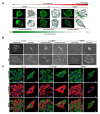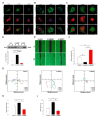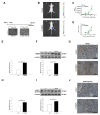High Mobility Group Box 1 Promotes Lung Cancer Cell Migration and Motility via Regulation of Dynamin-Related Protein 1
- PMID: 33807275
- PMCID: PMC8036886
- DOI: 10.3390/ijms22073628
High Mobility Group Box 1 Promotes Lung Cancer Cell Migration and Motility via Regulation of Dynamin-Related Protein 1
Abstract
High mobility group box 1 (HMGB1) has been demonstrated to promote the migration and invasion of non-small cell lung cancer (NSCLC). However, the mechanism of action of HMGB1 in regulating tumor mobility remains unclear. Therefore, we aimed to investigate whether HMGB1 affects mitochondria distribution and regulates dynamin-related protein 1 (DRP1)-mediated lamellipodia/filopodia formation to promote NSCLC migration. The regulation of mitochondrial membrane tension, dynamics, polarization, fission process, and cytoskeletal rearrangements in lung cancer cells by HMGB1 was analyzed using confocal microscopy. The HMGB1-mediated regulation of DRP1 phosphorylation and colocalization was determined using immunostaining and co-immunoprecipitation assays. The tumorigenic potential of HMGB1 was assessed in vivo and further confirmed using NSCLC patient samples. Our results showed that HMGB1 increased the polarity and mobility of cells (mainly by regulating the cytoskeletal system actin and microtubule dynamics and distribution), promoted the formation of lamellipodia/filopodia, and enhanced the expression and phosphorylation of DRP1 in both the nucleus and cytoplasm. In addition, HMGB1 and DRP1 expressions were positively correlated and exhibited poor prognosis and survival in patients with lung cancer. Collectively, HMGB1 plays a key role in the formation of lamellipodia and filopodia by regulating cytoskeleton dynamics and DRP1 expression to promote lung cancer migration.
Keywords: cytoskeleton dynamics; dynamin related protein 1; high mobility group box 1; lamellipodia/filopodia; mitochondrial fission; non-small cell lung cancer.
Conflict of interest statement
The authors declare no conflict of interest.
Figures






Similar articles
-
ERK/Drp1-dependent mitochondrial fission contributes to HMGB1-induced autophagy in pulmonary arterial hypertension.Cell Prolif. 2021 Jun;54(6):e13048. doi: 10.1111/cpr.13048. Epub 2021 May 4. Cell Prolif. 2021. PMID: 33948998 Free PMC article.
-
Recombinant High-Mobility Group Box 1 (rHMGB1) Promotes NRF2-Independent Mitochondrial Fusion through CXCR4/PSMB5-Mediated Drp1 Degradation in Endothelial Cells.Oxid Med Cell Longev. 2021 Aug 2;2021:9993240. doi: 10.1155/2021/9993240. eCollection 2021. Oxid Med Cell Longev. 2021. PMID: 34394840 Free PMC article.
-
YAP Inhibits the Apoptosis and Migration of Human Rectal Cancer Cells via Suppression of JNK-Drp1-Mitochondrial Fission-HtrA2/Omi Pathways.Cell Physiol Biochem. 2017;44(5):2073-2089. doi: 10.1159/000485946. Epub 2017 Dec 12. Cell Physiol Biochem. 2017. PMID: 29241219
-
The Regulatory Mechanisms of Dynamin-Related Protein 1 in Tumor Development and Therapy.Cancer Biother Radiopharm. 2021 Feb;36(1):10-17. doi: 10.1089/cbr.2020.3791. Epub 2020 Aug 6. Cancer Biother Radiopharm. 2021. PMID: 32762544 Review.
-
[Mechanism of mitochondrial fission - structure and function of Drp1 protein].Postepy Biochem. 2016;62(2):127-137. Postepy Biochem. 2016. PMID: 28132464 Review. Polish.
Cited by
-
Drp1: Focus on Diseases Triggered by the Mitochondrial Pathway.Cell Biochem Biophys. 2024 Jun;82(2):435-455. doi: 10.1007/s12013-024-01245-5. Epub 2024 Mar 4. Cell Biochem Biophys. 2024. PMID: 38438751 Review.
-
Mitochondria: a new intervention target for tumor invasion and metastasis.Mol Med. 2024 Aug 23;30(1):129. doi: 10.1186/s10020-024-00899-4. Mol Med. 2024. PMID: 39179991 Free PMC article. Review.
-
Role of Extracellular High-Mobility Group Box-1 as a Therapeutic Target of Gastric Cancer.Int J Mol Sci. 2022 Mar 17;23(6):3264. doi: 10.3390/ijms23063264. Int J Mol Sci. 2022. PMID: 35328684 Free PMC article.
-
Investigating the Effects of HMGB1 Overexpression on Colorectal Cancer Cell Migration via Oncolytic Herpes simplex Virus Type 1 (oHSV-1).Avicenna J Med Biotechnol. 2024 Apr-Jun;16(2):120-129. doi: 10.18502/ajmb.v16i2.14863. Avicenna J Med Biotechnol. 2024. PMID: 38618508 Free PMC article.
-
Rab32 promotes glioblastoma migration and invasion via regulation of ERK/Drp1-mediated mitochondrial fission.Cell Death Dis. 2023 Mar 15;14(3):198. doi: 10.1038/s41419-023-05721-3. Cell Death Dis. 2023. PMID: 36922509 Free PMC article.
References
MeSH terms
Substances
Grants and funding
- KMU-TC108A04-0/Kaohsiung Medical University Research Center Grant
- MOST 109-2314-B-030-002-MY2 and 108-2314-B-037-093-MY3/Ministry of Science and Technology, Taiwan
- KMUH108-8M10, and 108-8R14/Kaohsiung Medical University Chung-Ho Memorial Hospital
- CMU109-MF-106 and CMU109-S-37/China Medical University, Taiwan
LinkOut - more resources
Full Text Sources
Other Literature Sources
Medical
Molecular Biology Databases
Research Materials
Miscellaneous

